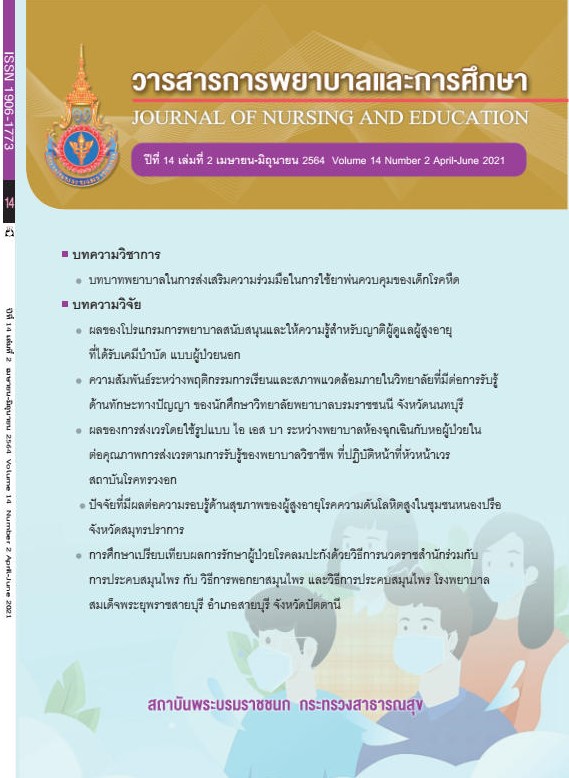บทบาทพยาบาลในการส่งเสริมความร่วมมือใน การใช้ยาพ่นควบคุมของเด็กโรคหืด
คำสำคัญ:
บทบาทพยาบาล, การส่งเสริมความร่วมมือ, ยาพ่นควบคุม, เด็กโรคหืดบทคัดย่อ
โรคหืดเป็นโรคเรื้อรังของระบบทางเดินหายใจที่พบบ่อยในเด็ก ปัจจุบันมีการพัฒนาแนวทางการดูแลผู้ป่วยโรคหืดและนำมาใช้อย่างแพร่หลาย อย่างไรก็ตามเด็กโรคหืดจำนวนมากถึงร้อยละ 50 ยังขาดความร่วมมือในการใช้ยาพ่นควบคุม ทำให้การควบคุมโรคหืดไม่มีประสิทธิภาพ เกิดอาการไอ หายใจเสียงดังหวีด แน่นหน้าอก หอบเหนื่อย บางครั้งอาการรุนแรงจนเกิดภาวะหายใจวาย และต้องเข้ารับการรักษา รวมทั้งอาจเกิดความเครียดและกังวลจากการเจ็บป่วยได้ นอกจากนี้ยังเกิดผลกระทบด้านจิตใจของผู้ดูแลเด็กโรคหืดอีกด้วย ดังนั้นพยาบาลจึงมีบทบาทสำคัญในการส่งเสริมความร่วมมือในการใช้ยาพ่นควบคุมโดยใช้กระบวนการพยาบาล เพื่อให้เด็กโรคหืดใช้ยาพ่นอย่างถูกต้องเหมาะสม และนำไปสู่การควบคุมโรคหืดได้ต่อไป
บทความนี้มีวัตถุประสงค์ เพื่อนำเสนอประเด็นที่เกี่ยวข้องกับ ความหมายของความร่วมมือในการใช้ยาพ่นควบคุม เครื่องมือที่ใช้ในการประเมินความร่วมมือในการใช้ยาพ่นควบคุม ปัจจัยที่มีความสัมพันธ์กับความร่วมมือในการใช้ยาพ่นควบคุม กลยุทธ์การส่งเสริมความร่วมมือในการใช้ยาพ่นควบคุม และกระบวนการพยาบาลในการส่งเสริมความร่วมมือในการใช้ยาพ่นควบคุมในเด็กโรคหืด
เอกสารอ้างอิง
2. Chinratanapisit S, Suratannon N, Pacharn P, Sritipsukho P, Vichyanond P. Prevalence and Severity of Asthma, Rhinoconjuctivitis and Eczema in Children from the Bangkok
area: The Global Asthma Network (GAN) Phase I. Asian Pac J Allergy Immunol. 2018;
36. doi.10.12932/AP-120618-0336.
3. Tangcheewawatthanaku C. Factors Associated with Disease Controlled in Childhood Asthma at Phang-nga Hospital. Reg 11 Med J. 2018; 32(4):1269-82. (in Thai).
4. Sattabud M. Asthma Knowledge, Level of Control and Quality of Life in Asthmatic Children at Lahansai Hospital. Journal of The Department of Medical Services. 2019;42(3):40-6.(in Thai).
5. Mirab ZK, Mirab ZB, Ghassem BF, Safa M, Khalil ZS. Prevalence of Depression in Children with Asthma. Eur Respir J, 2016;48 (suppl 60):35-47.
6. Bellin MH, Osteen P, Kub J, Bollinger ME, Tsoukleris M, Chaikind L, et al. Stress and Quality of Life in Urban Caregivers of Children with Poorly Controlled Asthma: A Longitudinal Analysis. J Pediatr Health Care. 2015; 29(6):536-46.
7. Thai Asthma Council. Thai Asthma. Guideline in Adults 2020. [Internet]. 2020 [2021 Jan 9]; Available from: http://www.tac.or.th/index.php/en/download/category/1-guidelines. (in Thai).
8. Tangpathomwong C, Nookong A, Senasuttipan W. Children and Caregiver Factors Predicting Asthma Control of School Aged Children. Journal of Nursing and Health Care. 2016; (34)2: 67-76. (in Thai).
9. Klok T, Kaptein AA, Duiverman EJ, Brand PL. Long-term Adherence to Inhaled Corticosteroids in Children with Asthma: Observational study. Respir Med. 2015;109(9):1114-9.
10. Sthapornnanon N. Medication Nonadherence. Thai Bulletin of Pharmaceutical Sciences. 2012; (7)1: 1-18. (in Thai).
11. Wanngamwiset S, Nookong A, Payakkaraung S. Factors Predicting Medication Adherence in School-Aged Children with Asthma in Tertiary Care Hospital. Journal of Health Science Research. 2019;13(2): 20-9. (in Thai).
12. Dima AL, Van GE, Laforest L, Texier N, de Bruin M. Measuring Medication Adherence in Asthma:Development of a Novel Self-Report Tool. Psychol Health.2017;32(10):1288-307.
13. Ngo CQ, Phan DM, Vu GV, Dao PN, Phan PT, Chu HT, et al. Inhaler Technique and Adherence to Inhaled Medications among Patients with Acute Exacerbation of Chronic Obstructive Pulmonary Disease in Vietnam. Int J Environ Res Public Health. 2019;16(2):185. doi:10.3390/ijerph16020185.
14. World Health Organization. Adherence to Long-term Therapies: Evidence for Action. [Internet]. 2003 [cited 2021; Jan 9]; Available from: https://www.who.int/chp/knowledge/publications/Adherence_section2.pdf?ua=1
15. Feldman JM, Kutner H, Matte L, Lupkin M, Steinberg D, Sidora-Arcoleo K, Serebrisky D, Warman K. Prediction of Peak Flow Values Followed by Feedback Improves Perception of Lung Function and Adherence to Inhaled Corticosteroids in Children with Asthma. Thorax. 2012; 67(12):1040-1045.
16. Sleath B, Carpenter DM, Slota C, et al. Communication during Pediatric Asthma Visits and Self-Reported Asthma Medication Adherence. Pediatrics. 2012;130(4):627-33. doi:10.1542/peds.2012-0913
17. Sriglun T, Wattnakitkrileart D, Sriyuktasuth A. The Effect of Asthma Management Program via Smartphone Applications on Knowledge, Inhaler Used and Symptoms Control in Patients with Asthma. Nurs Sci J Thail. 2021;39(2): 50-63. (in Thai).
ดาวน์โหลด
เผยแพร่แล้ว
ฉบับ
ประเภทบทความ
สัญญาอนุญาต

อนุญาตภายใต้เงื่อนไข Creative Commons Attribution-NonCommercial-NoDerivatives 4.0 International License.






